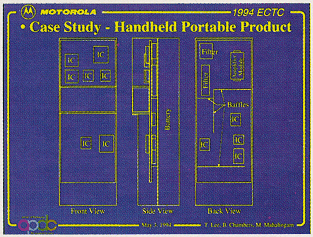摩托罗拉掌上便携技术
日期:2012-06-19
Motorola's Handheld Portable Technology - Validating CFD Technology |
|
Accurate prediction of the cooling requirements of new consumer products within as short a time scale as possible is of paramount importance to the success of Motorola. Tom Lee, Ben Chambers and Mali Mahalingam, from the companys Advanced Packaging Development Center, compared the accuracy of rapidly obtained results using FLOTHERM to those obtained from lenghtly experimental evaluations. The numerical results were in excellent agreement with the experimental data.

Handheld portable products comprise a large portion of Motorola's manufacturing business and represent one area where a Computational Fluid Dynamic (Computational Fluid Dynamics) software such as FLOTHERM can play a potentially important role in the design process. In this particular case study, Motorola chose a generic representative of its handheld products, for which experimental data already existed and thus could be compared to the results from the Computational Fluid Dynamics simulation. Problem Description Typically, handheld portable products are housed in sealed cases and rely predominantly on free convection for cooling. In general, the heat flow path in these types of products is a series of conduction and convection/ radiation paths. Much of the heat generated in a IC is first conducted into a PCB and from here into the outer case walls. Heat may be transferred through gaseous conduction, convection and/or radiative process, depending on the specification of the enclosure. The heat must then be conducted through the case walls and finally removed to the environment by free convection.
 Flotherm Model Flotherm Model
This case was modelled as a sealed enclosure comprising of a series of plates 0.8mm thick with a thermal conductivity of 0.6W/moC. The interior of the case consisted of a single circuit board containing all the IC packages and other components. Several baffles were present as an integral part of both the front and rear case halves and these effectively blocked the air flow between compartments. The circuit board was modelled using a block element with a thermal conductivity of 20W/moC, with larger circuit elements (IC packages, amplifier module, filter elements, etc..) also being modelled using block elements. Simulation Results The simulation predicted the external flow to approach velocities of up to approximately 0.2m/s, while the internal flows were nearly negligible (.02m/s), suggesting that the predominant mode of heat transfer inside this case design occurs through gaseous conduction. The maximum temperature occurring in the amplifier module was predicted to be 98.5oC, which compares to an experimentally determined temperature of 92.6oC for the same component, giving a difference of just 6.4% between predicted and measured temperatures.  Conclusions Conclusions
Results of this case and others performed by Motorola demonstrate the capability of FLOTHERM readily solved both internal and external fluid regions as well as the associated conduction problem. All available comparisons of simulated results were within 10% of experimental data, indicating that the tool will be a valuable asset in a design setting for predicting thermal performance |









 沪公网安备 31010602003953号
沪公网安备 31010602003953号